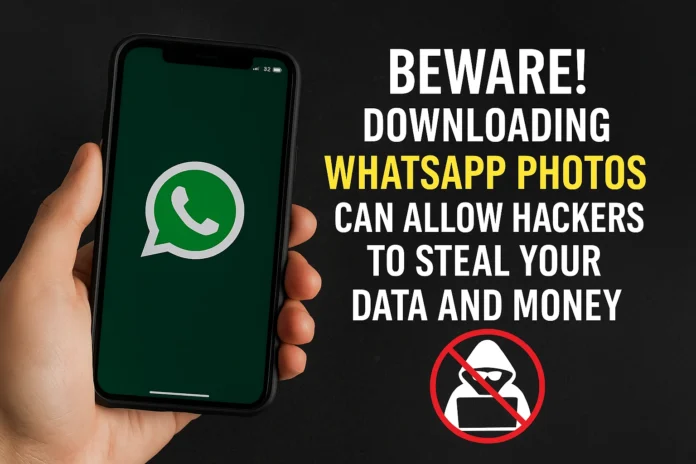Beware! Downloading WhatsApp Photos Can Allow Hackers to Steal Your Data and Money
WhatsApp is the go-to messaging app for over 2 billion users globally, offering seamless communication and multimedia sharing. However, cybersecurity experts are now raising alarms about a dangerous new threat: downloading photos via WhatsApp could expose your personal data, financial information, and even give hackers remote access to your device.
This alarming revelation underscores the growing complexity of mobile malware attacks, especially those targeting users in India and other emerging markets. Here’s what you need to know about this new scam, how it works, and what steps you can take to protect yourself.
What Is the New WhatsApp Photo Hack?
Cybersecurity researchers have discovered a method used by hackers where malicious code is embedded within innocent-looking image files shared over WhatsApp. When a user downloads or previews such an image, the malware is triggered, silently executing background scripts that can:
- Steal banking information
- Track keystrokes
- Access SMS messages (including OTPs)
- Monitor app activity
- Control your camera or microphone
This is often referred to as a “steganographic attack”, where hidden code is embedded within images or videos, making them harder to detect by conventional antivirus tools.
How Does the WhatsApp Photo Hack Work?
Here’s a step-by-step breakdown of how this cyberattack unfolds:
- A hacker sends a photo or video via WhatsApp, appearing to be from a trusted source or known contact (whose account may also be compromised).
- The victim downloads or previews the media, activating hidden malware within the file.
- Malware gains access to storage permissions and device resources.
- Sensitive data is transmitted to remote servers controlled by cybercriminals.
- In some cases, screen overlay attacks are used to trick users into entering sensitive information like banking credentials.
This method bypasses standard app permissions and antivirus software, making it one of the stealthiest threats targeting WhatsApp users.
What’s at Risk?
The consequences of downloading a malicious WhatsApp photo can be devastating. Here’s what users could potentially lose:
- Bank account access via stolen credentials or intercepted OTPs
- Digital wallet balances (Paytm, PhonePe, Google Pay, etc.)
- Personal documents and photos stored on the phone
- Social media access, leading to further impersonation and scams
- Remote access to the device, giving hackers full control
In several reported cases, users have lost tens of thousands of rupees after unknowingly opening such media files.
Who Is Most at Risk?
While this scam can affect anyone, some users are particularly vulnerable:
- Elderly users who may not recognize suspicious content
- Children and teenagers who download forwarded media without caution
- Users in WhatsApp groups where forwarded messages and media are common
- People using older phones with outdated security patches
India, being one of WhatsApp’s largest markets, is a primary target due to the high usage of UPI and digital wallets linked to mobile phones.
Real-Life Example: The Forwarded Image Scam
Ravi Sharma, a 28-year-old software professional from Delhi, recently fell victim to this scam. After downloading a forwarded image from a friend, he noticed his phone overheating and becoming sluggish. Within hours, ₹40,000 had been siphoned off from his Paytm account. Investigations revealed a hidden script in the image that accessed his SMS and banking app.
This case highlights how a simple image download can result in massive financial losses.
How to Stay Safe: Security Tips for WhatsApp Users
1. Disable Auto-Download for Media
Go to Settings > Storage and Data > Media Auto-Download and disable downloads for photos, videos, and audio unless on Wi-Fi or manually approved.
2. Avoid Unknown Contacts and Groups
Don’t accept image files from unknown numbers or recently joined group members. Exit suspicious groups.
3. Don’t Click Random Images or Links
Even if the media is from a known contact, verify its authenticity before opening it. Their account may have been compromised.
4. Use Strong Antivirus Software
Install a mobile security app that offers real-time scanning and app behavior monitoring.
5. Keep Your Device Updated
Security patches help fix vulnerabilities. Ensure your phone and apps are regularly updated.
6. Enable Two-Step Verification on WhatsApp
This adds an extra layer of protection against account hijacking.
7. Turn Off Media Visibility
Go to Settings > Chats > Media Visibility and toggle it off to prevent media from auto-saving to your gallery.
What to Do If You Suspect an Attack?
If you suspect you’ve downloaded a malicious file:
- Immediately disconnect your phone from Wi-Fi or mobile data
- Uninstall recently downloaded apps that seem suspicious
- Use antivirus to scan your phone
- Reset your WhatsApp PIN and unlink payment apps
- If financial fraud occurred, contact your bank or wallet provider immediately
- File a cybercrime complaint at cybercrime.gov.in
Final Thoughts
Cybercriminals are becoming increasingly sophisticated in how they exploit messaging platforms like WhatsApp. While the app itself is secure, the real risk lies in user behavior—especially when downloading media from unverified sources.
Staying informed, cautious, and proactive is the best defense. Never trust random images or forwards, no matter how harmless they look. The next time you tap to download a cute photo or meme, pause and think—could this cost you your privacy or money?



